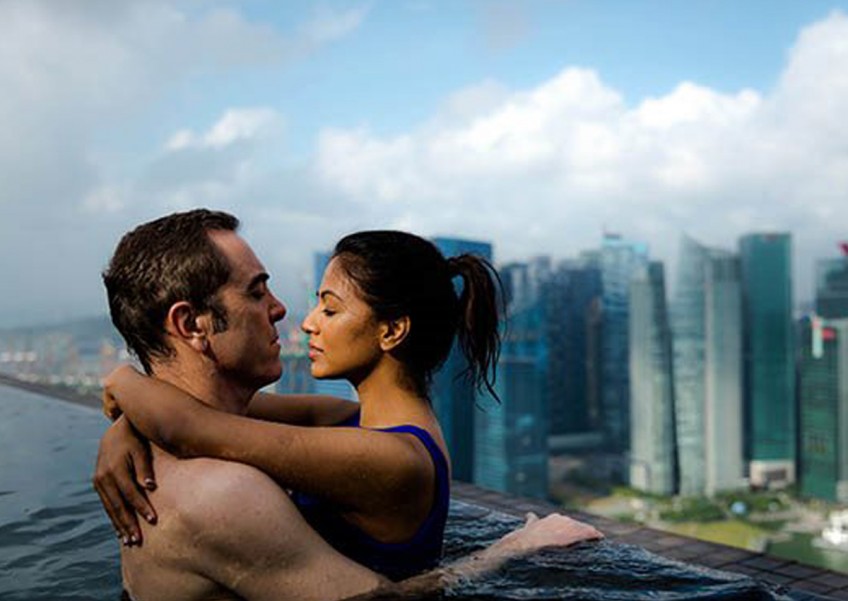Brit TV show Cold Feet altered scenes shot in Singapore to look 'more Singapore'

How Singaporean should Singapore be?
According to one British film production house, Molinare, it means changing all street signs from English to Chinese and removing British tourists from scenes filmed in Singapore.
A tweet-storm brewed over the weekend after Molinare revealed it had digitally altered scenes shot in Singapore for the British television series Cold Feet.
Actor James Nesbitt plays lead role Adam Williams, who works in Singapore.
Molinare's Daniel Mark Millar who spoke at London's Visual Effects Festival on Feb 9, said that the team shot footage in Singapore, but observed upon their return that the scenes resembled backgrounds in Manchester.
"They actually did shoot this in Singapore, but for some reason they shot it in 'Englishtown'," Mr Millar said.
"You know, we have a Chinatown in London, they have an Englishtown in Singapore," he added.
Now wouldn't you like to know what and where 'Englishtown' is?
Radio Times published two photos from the series; one of Nesbitt canoodling with co-star Karen David on what appears to be Marina Bay Sands' iconic infinity pool. He is pictured with Singaporean actress Tan Kheng Hua at Marina Bay in the other picture.

Mr Millar's comment quickly drew ire on Reddit and Twitter.
[embed]https://twitter.com/kixes/status/830310851806588928[/embed]
[embed]https://twitter.com/reddotdiva/status/830955005632868352[/embed]
[embed]https://twitter.com/mrbrown/status/830292245676859392[/embed]

Singapore's identity
Before you get all riled up reading this, there are two issues here that are worth unpacking.
First of all, how do you define Singapore's cultural anatomy?
Mr Millar said: "We had to make it look a bit more like Singapore - given it was Singapore."
Now, this brings to question what quantifies as the city state's essence.
According to Singstat's 2016 population report, Singapore is home to 5.61 million people, with non-residents making up an estimated figure of 1.67 million.
74.3 per cent are Chinese, 13.4 per cent are Malays, 9.1 per cent are Indians and the remaining minorities are grouped under 3.2 per cent.

Singapore is historically a Malay land, with immigration trends driving up numbers in the other ethnic groups since colonial times. As it stands, Malay is one of our national languages, while English is the official language of administration.
Regardless of ethnic diversity, students in Singapore schools are taught in English. The language is also the common mode of communication between the different ethnic groups - although a colloquial form called Singlish is still very much used.
Is 'Englishtown' a thing?
Secondly, no matter how bizarre Mr Millar's suggestion of an "Englishtown" was, he had a point.
The said "Englishtown" doesn't exist in modern Singapore, but its concept harks back to the 1822 Jackson Plan, an urban re-development programme designed by Lieutenant Philip Jackson.

This is the same plan that mapped out Chinatown, Little India and Kampong Glam. While the various ethnic groups settled in their respective quarters, European merchants were designated to European Town - which now makes up the Downtown Core, Singapore's financial hub.
Skyscrapers characteristically map out the Downtown area. It is after all, Singapore's Central Business District. With close proximity to attractions like Gardens by the Bay, Esplanade, Fullerton Hotel, ArtScience Museum and the Singapore River, it makes sense to observe the occasional tourist (British or otherwise) in the background.
Also, because Singapore was a Crown colony, there are remnants of the old British model still present: For instance, the country's parliamentary system is modelled after the Westminister system of parliamentary democracy.
Iconic landmarks like the present Fullerton Hotel, National Gallery and Victoria Concert Hall were built by the British while some roads like Albert Street and Ellenborough Street were named after British notables.
So yes Mr Millar, signs in English are relevant to our identity, just as much as British tourists are.
The skyscrapers, diversity and hordes of tourists - we claim them all.
debwong@sph.com.sg